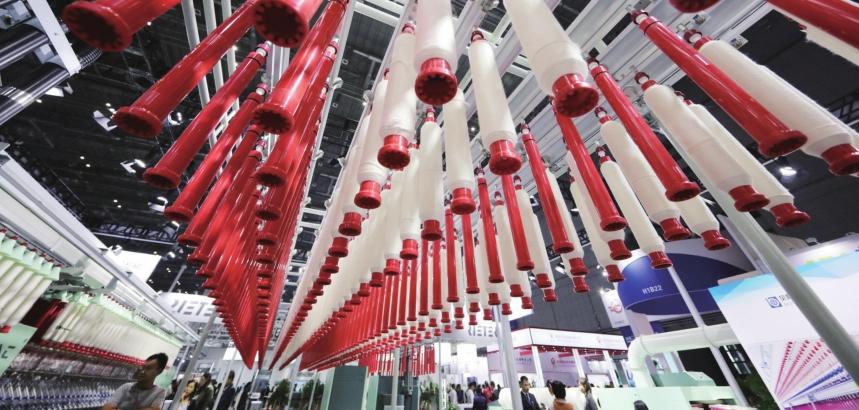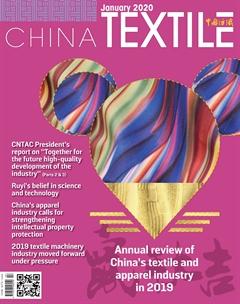2019 textile machinery industry moved forward under pressure

In 2019, under the framework of industry scale advantages and obvious manufacturing advantages, Chinas textile industry in 2019 was facing constraints from multiple factors such as labor, environment, and raw materials. In 2019, Sino-US trade frictions led to the differentiation and reorganization of the international trade pattern. As the key industrial chain nodes with advantages go abroad, such as the nonwovens industry, the comprehensive international competitive advantage of Chinas textile industry has been weakened to a certain extent; industrial upgrading and high-quality development were becoming an unprecedented topic of concern and an urgent goal to be achieved.
For the textile machinery industry, 2019 was also a difficult one. According to statistics from the National Bureau of Statistics, in the first three quarters of 2019, there were 668 enterprises above the designated size in the textile machinery industry in China, with 128 loss-making enterprises; operating income of 64.522 billion yuan, a year-on-year decrease of 5.279%; total profit of 4.358 billion yuan, a 7.73% decrease year-on-year.
According to customs statistics, in the first three quarters of 2019, Chinas textile machinery industry imports and exports totaled USD 5.595 billion, an increase of 4.91% year-on-year. Of which: USD 2.842 billion in exports, a year-on-year increase of 2.20%; and USD 2.752 billion in imports, a year-on-year increase of 7.85%.
However, difficulties and opportunities exist. In 2019, although the industrys economic operating environment was not satisfactory, and although the pace of the industrys reshuffle was significantly accelerated, we became more rational. In 2019, textile machinery enterprises actively responded to market changes, accelerated the pace of transformation and upgrading, and made great progress in terms of intelligent equipment and efficiency and profit.
More than a year ago, in March 2018, shortly before the United States raised tariffs on Chinese exports to the United States for the first time, President Donald Trump wrote on Twitter: “The trade war is a good thing, and it is easy to win.” Today, the visible negative effects of this trade war on the United States are more and more obvious.
Trade friction affects development confidence
Speaking of the development of the textile machinery industry and even the textile industry in 2019, Sino-US trade friction was an inevitable topic. Due to the influence of many international environments including the Sino-US trade friction and the adjustment of the domestic industrial structure, Chinas textile machinery market also fluctuated in 2019.
Gu Ping, president of China Textile Machinery Association, pointed out that China and the United States have 40% of the worlds GDP, the scope of trade frictions has gradually expanded, and the global supply chain is facing the risk of fragmentation, which has affected the global investment confidence to a certain extent. On the one hand, with the increase of uncertainty, enterprises should pay attention to the fluctuation of the consumer market; on the other hand, with the change of the industrial chain, industry enterprises are not only facing the transfer of orders, but also the higher and higher quality requirements for export yarn in foreign countries. The first priority is to make good products.
Many textile machinery enterprises reflected that they were indeed more difficult in 2019. Due to the increased inventory of yarns and cloths of downstream textile user enterprises, some original equipment orders were delayed or not picked up. However, some insiders also pointed out that this was mainly related to the law of the development of the industry. According to the development cycle, the textile machinery industry has indeed reached a trough period of development, and the industry cannot generally attribute it to Sino-US trade frictions. The impact of Sino-US trade friction on the development of the industry is mainly reflected in the future development uncertainty and corporate confidence.
On November 18th, Miao Wei, minister of the Ministry of Industry and Information Technology, said that manufacturing is the main body of the real economy and the core engine of long-term stable economic growth. Accelerating the transformation and upgrading of traditional industries is an important and urgent strategic task. We must attach equal importance to the cultivation and development of emerging industries and the upgrading of traditional industries, and regard the transformation and upgrading of traditional industries as an important support to promote the highquality development of manufacturing industries. He pointed out that traditional industries account for 80% of the added value of industries above the designated size, and they are still the mainstay of the industrial economy. The transformation and upgrading of traditional industries are related to the overall development of high-quality manufacturing. Traditional industries such as textile, clothing, home appliances, food and so on are related to the national economy and peoples livelihood, which account for a high proportion of exports, and are also important industries for stabilizing employment and foreign trade. It is important to focus on smart manufacturing, focus on technological transformation, and promote the transformation and upgrading of traditional industries.
High quality development is imminent
All signs indicate that the era of rapid development is becoming history. In the future, we should focus more on high-quality development and continuously improve our scientific and technological research and development capabilities. This is the foundation of development.
For the textile machinery industry in 2019, ITMA 2019 in Spain in June was an annual event. This exhibition was also a window for the entire industry to observe and predict future development trends. Li Xinqi, chief engineer of Hi-Tech Heavy Industry Co., Ltd., compared the current status of domestic equipment manufacturing enterprises after the exhibition and talked about his own point of view: Through ITMA, I felt that European enterprises have not reduced the importance of textiles. I thought that the whole textile machinery industry was transferred to China and Southeast Asia. In fact, from the perspective of ITMA 2019, European manufacturers mostly exhibited in kind, and many enterprises exhibited a large scale, which was shocking; non-woven fabric equipment is still in the direction of wide, high speed, high efficiency, combined with composite, equipment digital control, online monitoring, and online inspection are still the development trends; there are many manufacturers of recycling equipment, indicating that green and environmental protection are valued; chemical fiber equip-ment has not changed much, and the stability and efficiency of filament equipment, automatic jacking, automatic winding, automatic conveyance and storage, and other digital and automated equipment are the trend. The technological progress of European enterprises, continuous innovation and the speed of launching new products are accelerating. Domestic enterprises need to continuously increase self-renovation and narrow the gap with foreign enterprises. The processing accuracy and processing methods of foreign equipment are worthy of our study. Cotton spinning air spinning exhibits a lot. The traditional ring spinning will have an impact, and cotton spinning enterprises should prepare in advance and actively respond; the industrial design of foreign products is visually impactful, and domestic enterprises should strengthen the sense of design.
There are peak and trough in any economy. As long as it passes through the trough, it will definitely rise. When the market is not good, textile machinery enterprises must calm down and take full advantage of this opportunity to engage in research and development, product, and management. Fortunately, in the industry, such enterprises have been persistent in innovation and continuous change.
Good product is the first priority
In the case of a relatively surplus market, to avoid homogeneous competition, enterprises need to further improve their products. Under the new situation, Chen Shaojun, chairman of Zhejiang Yuanxin Co., Ltd. has taken the road to follow the market with its own characteristics and adhere to innovation: First, make original products, diversify products, and achieve continuous product updates; second, research new products, continuously launch revolutionary products, gradually eliminate the original backward machines, and guide customers to reposition, which is to develop products suitable for the market, that is, products with higher efficiency, energy consumption reduction and intelligence.
The market is changing rapidly, but the knowhow to be invincible in the market is relatively unchanged, that is, to move with the market change, or to advance the layout and guide the development of market demand. For example, in recent years, more and more cotton spinning enterprises have begun to use machine-picked cotton. Due to the high impurity content, relatively short fibers, and poor maturity of cotton-picked cotton, and textile enterprises require to use such raw materials to produce cotton yarn with higher quality than before. Zhang Yonggang, chairman of Guangshan White Shark Card Clothing Co., Ltd, said that we worked together with my colleagues in the spinning mill in order to make the card clothing better achieve the goals of opening, uniformity, impurity removal and straightening of the fiber, after dozens of varieties, dozens of manufacturers and hundreds of tests, we finally found that the toothed card clothing with the number 1816 solved these problems well, creatively reduced the cotton yarn nep by half, and even the removal rate could reach more than 90%.
In 2019, although the economic development environment was not satisfactory, the industry has never stopped its pace. In the very difficult year, many textile machinery enterprises took the initiative to grasp the general trend and follow the trend, and took their own extraordinary development path. The common feature of these enterprises was to put good products on the first priority of development.
- China Textile的其它文章
- Dear readers
- Together for the future high-quality development of the industry
- Annual review of China’s textile and apparel industry in 2019
- China’s apparel industry calls for strengthening intellectual property protection
- Ruyi’s belief in science and technology
- Textile machinery industry production and operation situation and development in 2020

